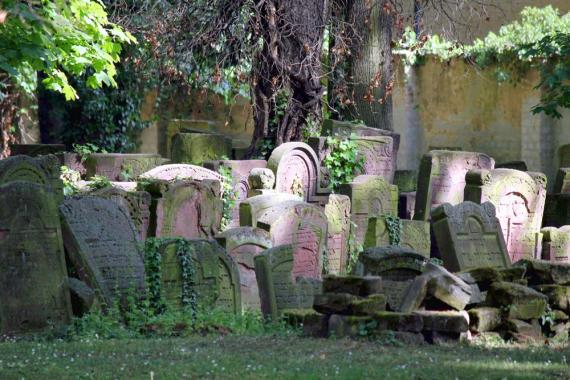Battonnstraße 32
60311 Frankfurt am Main
Germany
The first burials in the Battonnstraße Jewish Cemetery can be dated to 1272 on the basis of a few gravestones. This makes it one of the oldest of its kind in Europe. In Judaism, the cemetery is considered an eternal resting place; for this reason, the graves may not be dissolved, nor may the gravestones be removed. If no other land is available, earth is piled up in order to be able to bury the dead on top of each other. These burial rules lead to the typical picture of graves lined up in a very confined space, as is also the case on a small part of Battonnstrasse that is still originally preserved. When the capacities there are exhausted, it must be closed in 1828 with almost 7000 graves.
In 1942, the Nazis smashed approximately 4666 gravestones to rubble and piled them up for removal to cairns, some of which can still be seen today. 175 gravestones had already been removed, but not yet destroyed. Among them is the tomb of the founder of the banking dynasty Mayer Amschel Rothschild. In the 1950s, the gravestones were returned to their place of origin, but due to the lack of location information, they can only be placed along the cemetery wall. An exception are the stones of important religious and secular personalities, these are grouped together on a field of honor.
Interesting are the motifs on numerous tombstones, these are the house coats of arms of the deceased. The pictorial representations show the names of the houses, which were named after animals, mythical creatures and objects. This is a special feature of the Frankfurt Friefhof. A testimony of Jewish faith are the small stones on the gravestones as a sign of remembrance as well as the slips of paper with petitions in the cracks of some gravestones of especially revered rabbis. Among these is that of the eminent Talmud scholar Pinchas haLevi Horowitz, who served as rabbi in Frankfurt from 1772 until his death in 1805. The burial ground can be entered from Battonnstraße through a gate, the key is given to the visitor upon depositing an identification document at the Museum Judengasse, except on Jewish holidays. Male visitors are expected to wear headgear (e.g., a kippah).


Add new comment